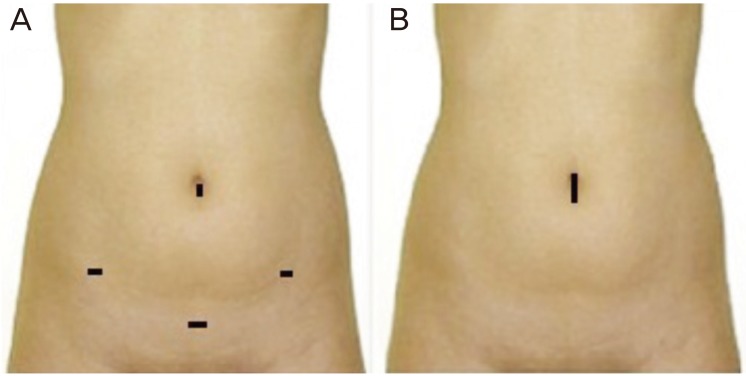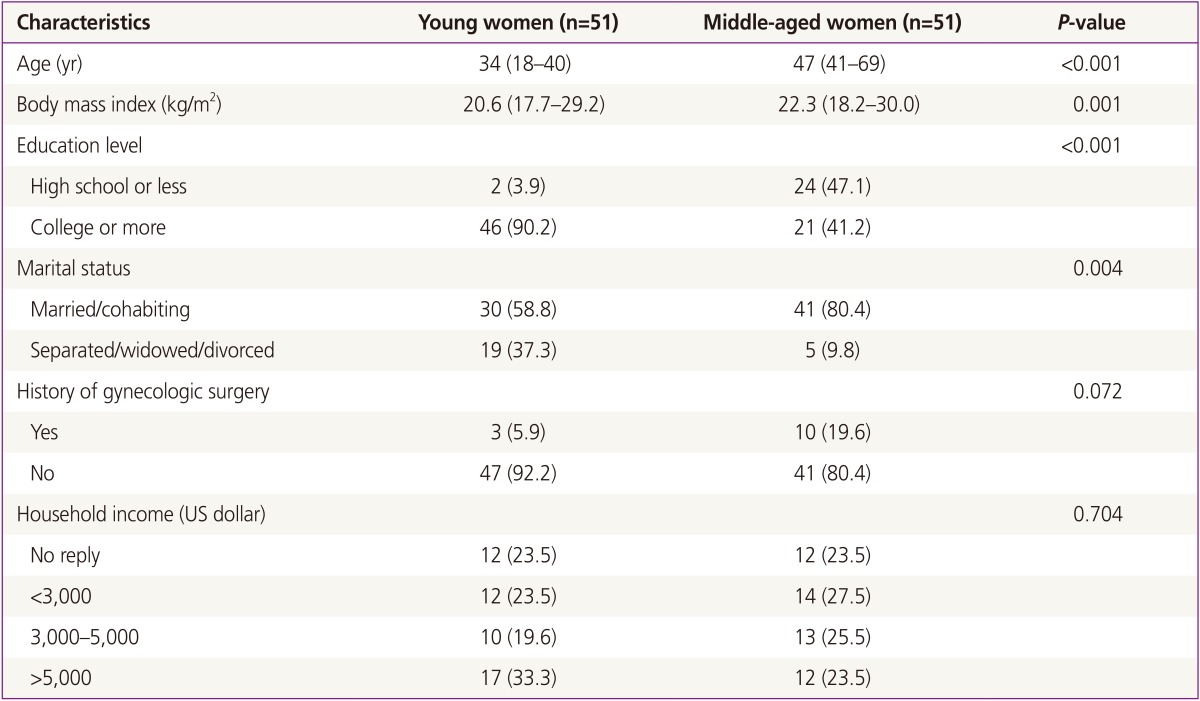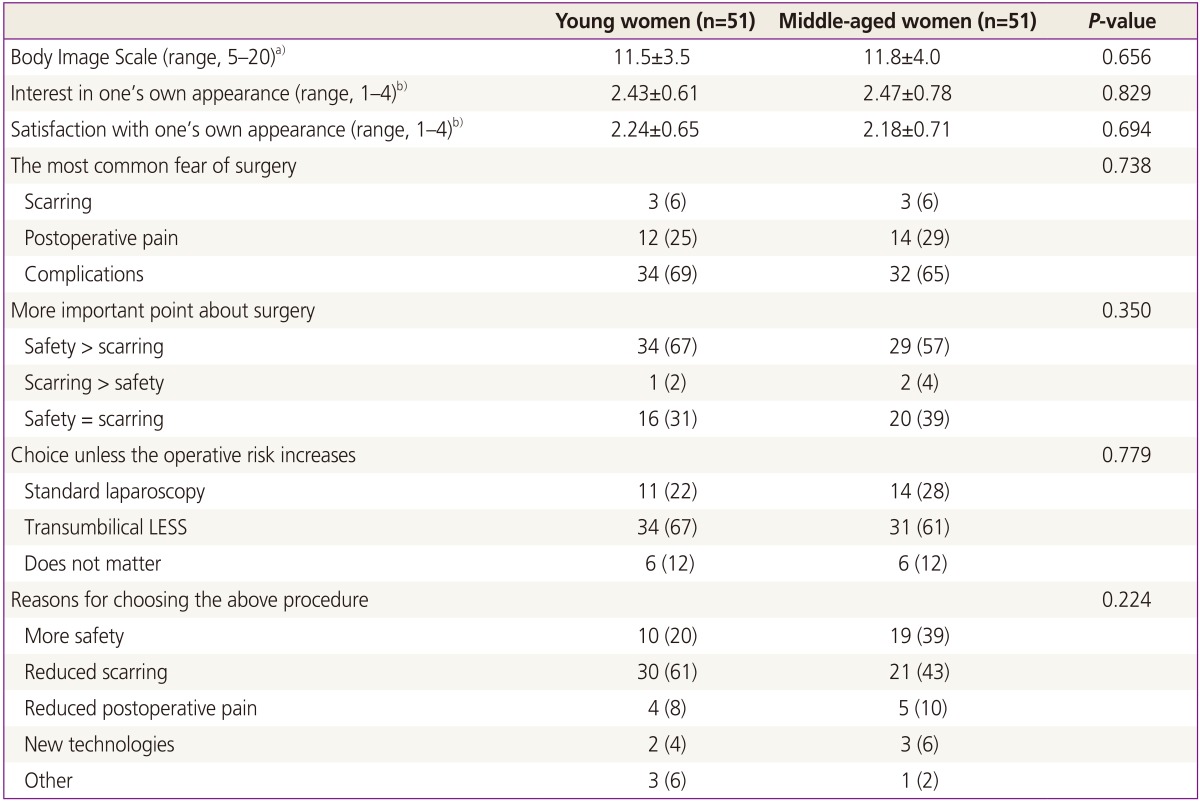Public perception of "scarless" laparoendoscopic single-site surgery in gynecology
Article information
Abstract
Objective
To investigate the public perception of laparoendoscopic single-site surgery (LESS) according to the age group.
Methods
An anonymous questionnaire about the desire for cosmesis and the preference for LESS in treatment of benign gynecologic diseases was provided to healthy volunteers (n=102). The survey participants were divided into two age groups (young women ≤40 years and middle-aged women >40 years). The desire for cosmesis was assessed using a validated scale, Body Image Scale.
Results
All of the participants completed the questionnaire. The Body Image Scale scores were not different between the two age groups (11.5±3.5 vs. 11.8±4.0, P=0.656). The most common fear of surgery was the risk of complications in both age groups (69% in the young age group and 65% in the middle-aged group). Unless the operative risk increased, most of the participants (61% to 67%) in both age groups preferred LESS. Their choice was influenced by reduced scarring (43% to 61%), more safety (20% to 39%), reduced postoperative pain (8% to 10%), and new technology (4% to 6%).
Conclusion
Based on these results, there was no difference in the desire for cosmesis and perception of LESS according to the age. Therefore, physicians should discuss and consider LESS even in middle-aged women.
Introduction
Because of the advantages of laparoscopy such as less pain, shorter hospital stay, improved cosmesis, and fewer postoperative complications, it has replaced open surgery and has become the standard of care for many operations for benign gynecologic disease [123]. However, each working trocar has an inherent risk of hemorrhage, infection, organ damage, hernia formation and decreased cosmesis. Therefore, the fundamental goal of minimally invasive surgery is to reduce the number of trocars required to perform the procedure [4].
Recent technological advances in laparoscopic instruments and optics have enabled the development of a less invasive alternative to conventional laparoscopic surgery (CLS): laparoendoscopic single-site surgery (LESS). However, LESS is a challenging operation even for an experienced laparoscopic surgeon. Assuming that middle-aged women, unlikely young women, were less interested in decreasing surgical scarring, some surgeons tend to be reluctant to perform LESS in this age group [5]. However, there is no study assessing the public perception of surgical scars or LESS according to the age group. We hypothesized that the desire for cosmesis and the preference for LESS in middle-aged women were not different from those in young women. Therefore, the aim of this study was to investigate the public perception of LESS according to the age group.
Materials and methods
1. Participants
After obtaining approval for this study from the institutional review board, a survey among healthy volunteers was performed at the Kangbuk Samsung Total Health Care Center (Screening Center) between October 2014 and November 2014. Inclusion criteria included women aged 18 to 70 years who visited our center for a medical check-up. Exclusion criteria were as follows: diabetes mellitus; use of chemotherapeutic agents or other medications, such as steroids, that would affect wound healing; pregnancy; dermatologic disorder such as scleroderma; a recent surgical complication such as wound infection or dehiscence; and inability to read and write in order to understand and complete the informed consent and questionnaire.
2. Outcome measure
The primary outcome of this study was the desire for cosmesis and the preference for LESS in treatment of benign gynecologic diseases. The desire for cosmesis was assessed using the Body Image Scale (BIS), which measures participant's perception and satisfaction with general bodily appearance, and includes 5 questions scored using a 4-point Likert scale, as previously described [67]. The maximum BIS score is 20, with higher scores indicating greater desire for cosmesis. Additional questions were asked to evaluate participants' interest and satisfaction with their own appearance, the most important point about surgery, preference for the surgical technique (CLS or LESS), and reason for their choice. Participants were shown 3×1.5-inch photographs of a female abdomen with incision sites marked for CLS with three 5-mm incisions and a 12-mm suprapubic incision, and LESS with a 20-mm intra-umbilical vertical incision (Fig. 1). Participation in the study was voluntary, and a hand sanitizer costing one dollar was provided to the participants.
3. Statistical analyses
At the time of the study design, because of the lack of studies determining the BIS score in Korean general women, we conducted a pilot study to estimated the required sample size. The BIS score was measured in 20 parents who visited patients at our center (mean±standard deviation [SD], 11.9±2.6). We assumed that equivalence was clinically significant if the difference in the BIS score was 1.5 between the two age groups with a SD of 2.6. Setting the type 1 error and power at 5% and 80%, respectively, and allowing a 7% dropout rate, the required sample size was 51 participants in each group.
All statistical analyses were performed using IBM SPSS ver. 20.0 (IBM Corp., Armonk, NY, USA). Participants were divided into two age groups: young women (defined as women aged ≤40 years) and middle-aged women (defined as women aged >40 years). Data are presented as means±SD or medians (range) for continuous variables, and frequencies (percentages) for categorical variables. Baseline clinical characteristics and study outcomes were compared between the two age groups using the Student's t-test or the Mann-Whitney test for continuous variables, and the chi-square test or Fisher's exact test for categorical variables, as appropriate. P-values <0.05 were considered to be statistically significant.
Results
All of the total 102 women enrolled in this study completed the questionnaire. The demographics of participants are shown in Table 1. The mean body mass index was 20.6 (17.7 to 29.2) and 22.3 (18.2 to 30.0) in the young and middle-aged groups, respectively (P=0.001). Also, 12.7% of the participants had a history of prior gynecologic surgery. The education level was significantly higher in the young age group than in the middle-aged group (90.2% vs. 41.2%, P<0.001). The proportion of married or cohabiting women was significantly lower in the young age group than in the middle-age group (58.8% vs. 80.4%, P=0.004)
Table 2 presents the public perception of LESS for benign gynecologic diseases. The BIS scores were not different between the two age groups (11.5±3.5 in the young age group versus 11.8±4.0 in the middle-aged group, P=0.656). The most important concern regarding surgical therapy was the fear of surgical complications, which was 69% in the young age group and 65% in the middle-aged group (P=0.738). Participants stated that safety was a more important point about surgery than scarring (67% in the young age group and 57% in the middle-aged group, P=0.350). When responding to the question 'if the operative risk of the two surgical approaches (CLS and LESS) was equal, which of the two would you choose?', 61% to 67% of the participants opted for a LESS approach, whereas 22% to 28% preferred CLS, with no statistical difference between the two age groups (P=0.779). The reasons for their choice between the two surgical approaches (either CLS or LESS) were reduced scarring (43% to 61%), more safety (20% to 39%), reduced postoperative pain (8% to 10%), and new technology (4% to 6%).
Discussion
In this study, we found that the desire for cosmesis in middle-aged women was not different from that in young women. We also found that the main concern of the survey participants was the risk of surgical complications (65% to 69%). Unless the operative risk increased, most of the participants (61% to 67%) in both age groups preferred LESS. Based on our results, physicians should be more assertive in conducting LESS in the middle-aged women, similar to the young women. Moreover, the knowledge gained from this survey might promote the surgeons to increasingly perform the LESS approach. To the best of our knowledge, this is the first study to analyze the public perception of LESS according to the age group.
The present study showed that majority of women (61% to 67%) preferred LESS to CLS unless the operative risk increased. This finding was in agreement with the findings of the study by Goebel et al. [10], a survey among 100 women between the ages of 20 and 40 years with respect to the public preference for cosmetic results after various gynecologic surgeries including Pfannenstiel, mini-laparotomy, CLS, and robot-assisted laparoscopy. They found that 64% of women preferred the appearance of a LESS scar when that option was provided. They concluded that large-scale adoption of the scarless LESS might result from the strong desire for cosmesis as well as surgical safety. This corresponds to the increase in the number of plastic and cosmetic surgeries performed worldwide.
In this study, the preference for LESS in middle-aged women was not different from that in young women. Our result was in accordance with that in the study by Autorino et al. [8], in which the preference for LESS in patients above the age of 60 years was more than 30%, and not only in young women. A study by Fransen et al. [9] found that age did not influence the perception of surgical safety and cosmesis. Ross et al. [11] also reported that age did not correlate with the willingness to undergo LESS surgery. On the contrary, Bucher et al. [5] reported that favorable adoption of scarless surgeries such as LESS was positively influenced by younger age.
The present study has several limitations. First, we included a relatively small number of study participants, although it was based on the sample size calculation. Second, our study participants were Korean women who were living in an urban area, and therefore, these results may not be applicable interested in the medical information.
In conclusion, there was no difference in the desire for cosmesis and the perception of LESS according to the age. Considering that the prejudice in our society relatively underestimates the cosmetic desire of middle-aged women, physicians should be more assertive in the decision-making process of choosing LESS. Additional studies involving a large number of patients are necessary to confirm the data from this study.
Notes
Conflict of interest: No potential conflict of interest relevant to this article was reported.


